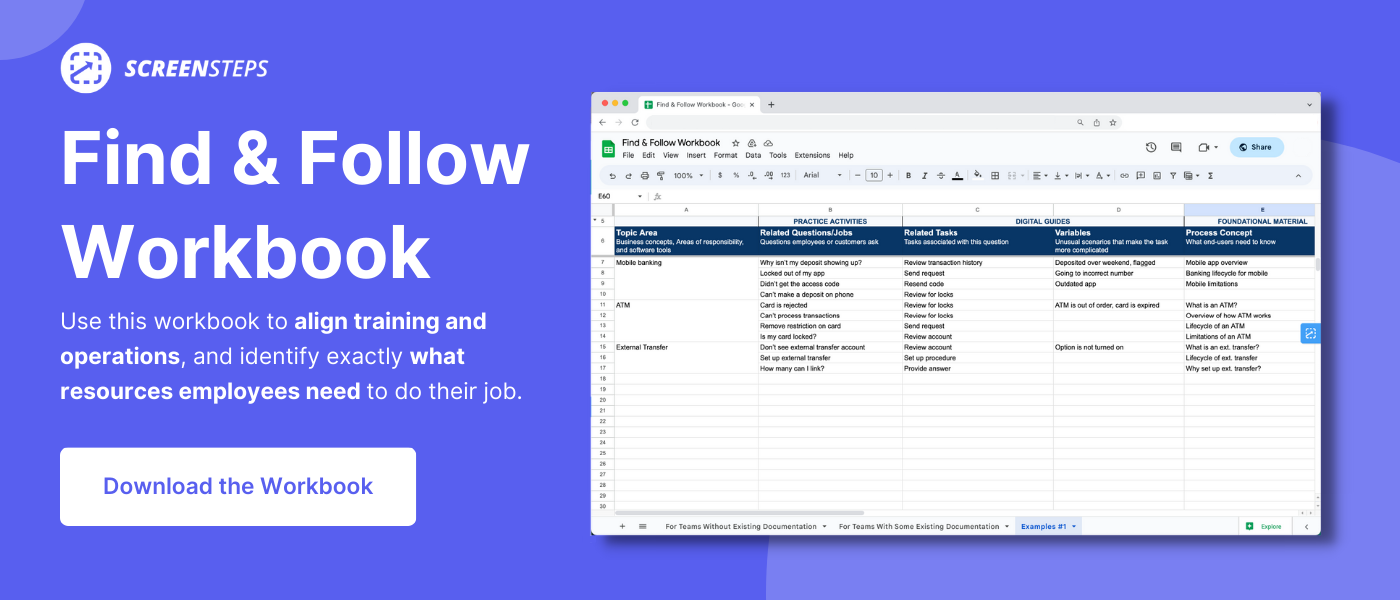9 Mistakes Trainers Make in Call Center Agent Training (+ Fix-It Tips)
When you think of call center training, what do you envision?
If I were to guess, I’d imagine you pictured sitting in a room with no windows, a lot of PowerPoint presentations, and packets of paper on the desk in front of you.
What if I were to tell you that each of those images is a call center training mistake?
I know! It’s hard to believe that these common practices are outdated, but they are.
For nine years, I’ve helped businesses develop training programs for their employees as part of my job for ScreenSteps, a knowledge base software company. During that time, I’ve identified common mistakes businesses make with their training programs.
If you want to train more effective call center agents, try to avoid these nine mistakes as part of your call center training program.
Mistake #1: Not coordinating with supervisors on the training curriculum
First, your trainers oversee your new hires. Then your floor supervisor, team lead, or manager oversees your new hires.
Sometimes, trainers and supervisors are not on the same page. Trainers put together a training plan that includes dozens of topics that reps must “know.”
But, when reps leave training and hit the floor, they aren’t able to actually handle calls on their own and they end up asking supervisors tons of questions.
This can cause a bit of frustration and tension between trainers and supervisors. When reps make mistakes or ask questions, supervisors ask, “Did you cover ______ during training?” It can become a bit of an unhealthy blame game.
Reps also become frustrated and confused. It complicates their jobs to have to ask their supervisors questions all the time. It can feel like they need to ask a question for every call they receive.
Plus, it can be confusing when it feels like your training is contradicting what your supervisor needs you to do on the floor.
How to fix it
While you are in separate departments, you need to have a cohesive plan on how to help your new hires reach proficiency.
Ask supervisors, “What do you need reps to be able to do when they come out of training?” From that, they should get a very specific list of the types of questions and requests reps need to be able to resolve.
Mistake #2: Focusing on what reps should “know”
It’s very common in the world of learning and development to put together training curriculums that cover objectives such as “Understand topic C” and “Know about subject D.” But, reps need to do more than just understand things.
While it will always be true that reps need to “know” things, a more accurate statement is that they need to be able to apply their knowledge to resolve calls. In short, they need to be able to DO things.
Instead of focusing on what reps should “know,” identify the tasks that reps need to be able to do (see mistake #1). Then do learning activities that recreate scenarios where reps can practice doing those tasks.
How to fix it
Start with figuring out those situations where they need to apply knowledge. Then work backward to identify what knowledge they actually need.
One way to figure out which task your call center reps need to be able to do is by hosting a content planning workshop. This helps you identify articles to include in your call center knowledge base, which consequentially are the same tasks your agents need to be able to do.
Here’s a guide to how to host a content planning workshop, including who to invite to your brainstorming meeting.
Mistake #3: Creating video tutorials that walk reps through the clicks
You want to show your call center reps how to perform processes and procedures, so you record your screen and talk through the steps.
Here’s the problem (well, two of them to be exact):
- Your reps can’t remember what they watched.
- They can’t reference the video on a call.
When they are on a call and need that procedure 15 days after watching the video, they can’t remember every step.
And your reps can’t watch a video when they are on a call with a customer. That would mean they need to put the caller on hold, spend time watching the video, and then return to the call. They don’t have 40 minutes or even 30 seconds to watch the video you prepared.
That’s an unrealistic way for an agent to get help.
How to fix it
Instead, put the details of where to click in a documented procedure or a work instruction. Write out these step-by-step instructions, include screenshots, and make them accessible for all of your agents.
Use a knowledge management system — like call scripting software, document library, or knowledge base — to make it easier for your agents to access the guides.
Save videos for explaining high-level concepts or the high-level process. That can be background information or details that allow them to quickly follow the written step-by-step procedural instructions.
Mistake #4: Including details in PowerPoint slides
During training, it is tempting to create a PowerPoint slide that includes all the nitty-gritty details about a procedure. The expectation is that if reps have seen it during a presentation, they’ll remember it. Unfortunately, that NEVER happens.
Your new hires are learning a lot of information during your training sessions. Their minds can only latch on and remember so many tidbits.
Referencing your slides for details on a call won’t work. It’s too difficult for agents to find the information they need in your 95-slide PowerPoint deck. They don’t have time to scroll through that while they are on a call.
How to fix it
The alternative and solution to using PowerPoint presentations are similar to the solution for videos. Document step-by-step processes and procedures your agents can pull up while they are on a call.
Instead of putting details in your PowerPoint slides, create job aids that include the screenshots and details. This way, reps can access the details when training is over. They can use the guides while they are on a call with your customers.
Mistake #5: Using unrealistic activities
Trainers are often guilty of unloading information. Onboarding sessions consist of a lot of lecturing
Trainers understand all the context for how to use information during a call. But, reps do not have that context yet. So you need to give it to them!
You can do that by sharing on-the-job scenarios, but even telling stories is enough. The agents must practice finding answers since they will be on their own for phone calls.

Here’s a poor example of training (aka something you don’t want to do):
At a member warehouse, the difference between a full member and a part member is that full members have more benefits than part members.
Instead, do an activity where John calls in asking, “Why can’t I see the complete list of promotions like it shows on the email newsletter?” The trainer would simply teach reps that the reason is John is a part member and they don’t have as much access as full members.
They hear about this one situation and learn the reason, but they didn’t learn how to resolve the situation on their own. If a similar situation happens in the future around part- vs. full-member status, the agents don’t have the skills to resolve it on their own.
How to fix it
Instead of unloading information, practice realistic scenarios so reps can see how the information can be used to resolve a call.
So, in the example above, you wouldn’t just have your agents learn that John was a part member. You would teach them to pull up an article and troubleshoot why he was having viewing issues.
The documented procedure would help them find the answer that John is a part member who doesn’t have access to those deals.
Scenario-based training is an opportunity for your call center agents to role-play real situations that they will encounter in the call center. It helps them practice different scenarios.
Need help coming up with scenarios to practice in training? Use this collection of common call center scenarios to start your list of practice scenarios.
Mistake #6: Training and coaching don’t align
If your call center has 10 ways to do the same thing, your new reps are going to be confused. Are they supposed to do it the way they learned in training or the way they learned it from their phone coach? Or maybe the way their tenured neighbor showed them?
During training, they’ll develop confidence in handling calls one way (the way you taught them). Then, if your phone coaches start giving them different advice, your reps will lose confidence and begin performing poorly.
Your call center needs one official way to handle situations and everyone needs to be in sync.
How to fix it
Standardize your policies and procedures. From the top-down, decide on one way to do each procedure. Then document those steps in a guide that anyone in your call center can follow.
Mistake #7: Spoon-feeding reps
Learning is sometimes uncomfortable. And those uncomfortable situations make agents nervous. Sometimes during training, you are tempted to respond to agent discomfort by spoon-feeding the agents answers.
But, learning and growing require messing up and feeling uncomfortable. A butterfly must struggle to get its wings. Reps must struggle a bit to learn the ropes.
There is no safer environment to make mistakes in or fail at a procedure than a training session. Those mistakes have no consequences. Agents have an opportunity to learn from their errors.
How to fix it
Allow reps to struggle during training so they don’t struggle as much on the floor.
As long as you have resources reps can leverage, let them spend 10 minutes finding the right one. It’s not fun, but it’s effective. They’re learning as they do the work.
If you don’t have the resources to help reps, let them sit in the struggle for a bit and then guide them by asking questions and helping them figure it out for themselves.
Mistake #8: Not teaching reps how to be self-sufficient learners
There are many different approaches to training. You don’t want all of your call center agents’ learning to come from you.
This goes back to spoon-feeding your reps answers. They won’t maintain that information you told them as much as they will from practicing applying the principles over and over again. You want your agents’ biggest teachers to be themselves.
But, wait! They don’t know the business. How can they train themselves?
How to fix it
First, you teach them a short presentation (or a mini-course with videos and written tutorials) that covers the basic information so that reps have some context. Then you set your agents loose to try procedures.
This is called scenario-based training. It’s hands-on learning.
For example, if you were a bank, a topic might be checking accounts. You would have a short presentation that explains the basics of checking accounts.
Then, you would jump into realistic scenarios related to that topic.
Continuing the example of checking accounts, you would do scenarios such as, “Maria calls in asking for more checks,” “Ted calls in asking what the fees are for the basic checking account,” and “Sam calls in requesting to cancel his checking account.”
Then, instead of jumping in and telling reps exactly what to do, you would let your reps figure out how to respond to those calls using your internal procedure documents.
Reps will have to actually navigate through your shared drive/intranet/knowledge base (whatever you’re using) to find the correct policy, procedure, job aid and follow it to respond to the call.
Mistake #9: Making reps memorize things they don’t need to
Many call centers have their new agents spend months in training so that they can memorize every policy, process, and procedure in the company.
Often that’s because they have a lot of procedures or they have complex procedures. If reps make mistakes, they can cost the call center a lot of money.
But memorization isn’t the only way to make sure agents don’t make mistakes. And not all information needs to be memorized. Their memories are bound to fail them at some point, no matter how good they are at memorization.
For example, if you are a medical call center, it’s a good idea for reps to memorize HIPAA restrictions on how much medical information you can share. BUT, they do NOT need to memorize the details for who can hear what.
Instead, you should create a matrix that reps can reference when they are not sure.
How to fix it
Determine what reps absolutely need to memorize and what they can reference. You’ll want a central location — like a knowledge base, document library, or wiki — where your agents can find these reference resources.
When determining whether you should have your reps memorize something or if you should create a reference sheet, think of this:
- Memorize: Things that provide context (e.g. high-level idea of a process, policy, or customer type)
- Reference: The application of policies, processes, and procedures
Build a call center training program that yields confident and independent agents
Training call center agents can be an intimidating task. There is a lot of information for your agents to learn and different skills to master. Knowing the common mistakes helps you build a call center training program that sets your reps up for success.
At ScreenSteps, we provide knowledge base software that supports your employees during training and on the job. Using the knowledge base software, it is easy to create help guides as well as easy for your call center agents to access those guides.
Agents don’t need to put the caller on hold to find answers to questions. When you use your knowledge base articles with scenario-based training, your agents learn to be more independent and resolve problems on their own.
Looking to refresh your call center training program? Learn how to organize your call center training program into five phases, including incorporating scenario-based training.


.png)


